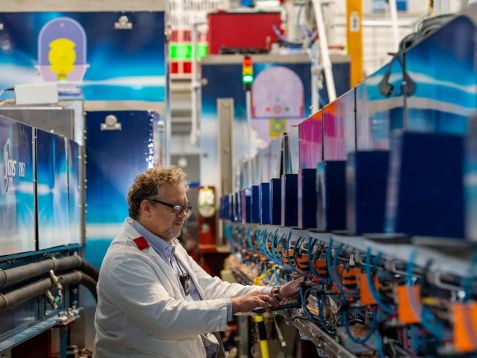MLZ is a cooperation between:
 > Technische Universität München
> Technische Universität München > Helmholtz-Zentrum Hereon
> Helmholtz-Zentrum Hereon
 > Forschungszentrum Jülich
> Forschungszentrum Jülich
MLZ is a member of:
 > LENS
> LENS > ERF-AISBL
> ERF-AISBL
MLZ on social media:

MLZ (eng)
Lichtenbergstr.1
85748 Garching
30.08.2022
Neutrons Provide New Insight into Protein Folding
Proteins are one of the basic building blocks of life. They provide structure, enable movement and catalyse metabolic processes. With the help of neutrons, a German-Japanese research team has now discovered a previously unknown protein structure – an important step towards better understanding the complex folding processes of proteins.
The basis of proteins is made up of amino acids, a total of 21 different types in humans, strung together in a chain formation. For proteins to function properly, the chains must be able to fold and entangle to form complex three-dimensional structures. Studying and correctly predicting these folding processes is a major challenge for scientists. New insights into this complexity have now enabled a team of researchers from Forschungszentrum Jülich and Japan to conduct new investigations using neutrons as probes at the Heinz Maier-Leibnitz Zentrum (MLZ) in Garching.
New protein structure discovered
Using small-angle neutron scattering, the Jülich researchers, together with colleagues from the University of Ibaraki, have been studying the protein cytochrome c´ under different pH conditions and discovered a previously unknown structure of the protein. Cytochrome c´ and related proteins are found in almost all living organisms, including humans, and are used to transport electrons. It is currently speculated that defective cytochrome c´ proteins could cause disease. The researchers used a cytochrome c´ from bacteria in their investigations.
They discovered the new structure under strongly alkaline conditions. Despite the fact that such conditions are unusual in nature, they nevertheless demonstrate the type of folding possible in principle. “Only neutrons make it possible to study protein structures under these kinds of environmental conditions,” explains Dr. Henrich Frielinghaus, instrument scientist at the Jülich neutron small-angle instrument KWS-1 at the MLZ. “Step by step, these findings contribute to improving our ability to understand and predict the complex folding processes of proteins.”
Neutrons enable investigation in natural environment
Scientists normally use X-ray crystallography to determine the three-dimensional structure of proteins. As proteins in their natural form cannot withstand the energy-rich X-rays long enough for a measurement to take place, the proteins are first converted into crystals. The periodically ordered atoms in the crystals scatter the X-rays much more vigorously. The atomic structure of the crystal can then be reconstructed from the resulting image. However, this is a complex procedure that could also deliver inaccurate results. This is because the protein as a crystal usually takes on a form that is energetically favourable in this unnatural environment.
Neutrons are much gentler probes when compared to X-rays. Crystallization is therefore not necessary for structural studies using neutrons, as the proteins can be examined in solution. A wide range of different conditions can thus be created, such as conditions typical of the protein’s natural environment, but also those that could occur in nature for just a short period of time or only in parts of the protein, e.g. while a protein chain is being synthesized and is forming its three-dimensional shape. Not only this, the freedom of movement of the proteins is preserved in solution. As a result, many possible protein structures superimpose each other in a single sample; these cannot be observed using X-ray crystallography, but can however be studied using neutrons.
Text: A. Wenzik, Forschungszentrum Jülich
Original publication:
Yamaguchi, T.; Akao, K.; Koutsioubas, A.; Frielinghaus, H.; Kohzuma, T.
Open-Bundle Structure as the Unfolding Intermediate of Cytochrome c´ Revealed by Small Angle Neutron Scattering.
Biomolecules 2022, 12, 95. DOI: 10.3390/biom12010095
Further information:
Jülich Centre for Neutron Science
Heinz Maier-Leibnitz Zentrum
Contact:
Dr. Henrich Frielinghaus
Forschungszentrum Jülich
Jülich Centre for Neutron Science at the Heinz Maier-Leibnitz Zentrum (JCNS-MLZ)
Tel: +089 158860-706
Email: h.frielinghaus@fz-juelich.de
Press contact:
Angela Wenzik
Science Journalist
Forschungszentrum Jülich
Tel. 02461 61-6048
Email: a.wenzik@fz-juelich.de
MLZ is a cooperation between:
 > Technische Universität München
> Technische Universität München > Helmholtz-Zentrum Hereon
> Helmholtz-Zentrum Hereon
 > Forschungszentrum Jülich
> Forschungszentrum Jülich
MLZ is a member of:
 > LENS
> LENS > ERF-AISBL
> ERF-AISBL
MLZ on social media:



